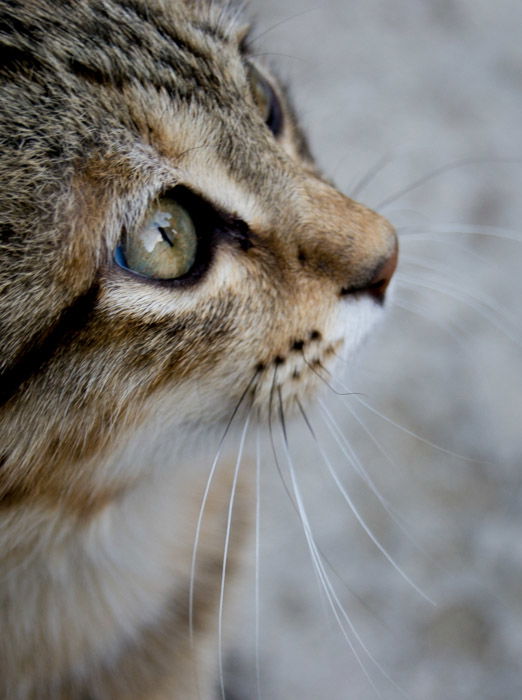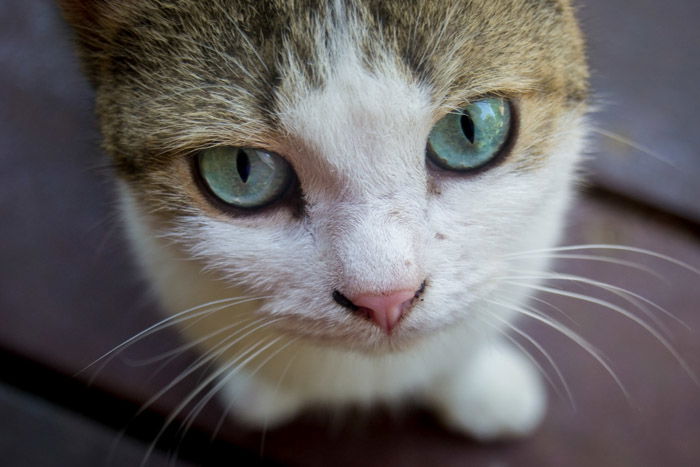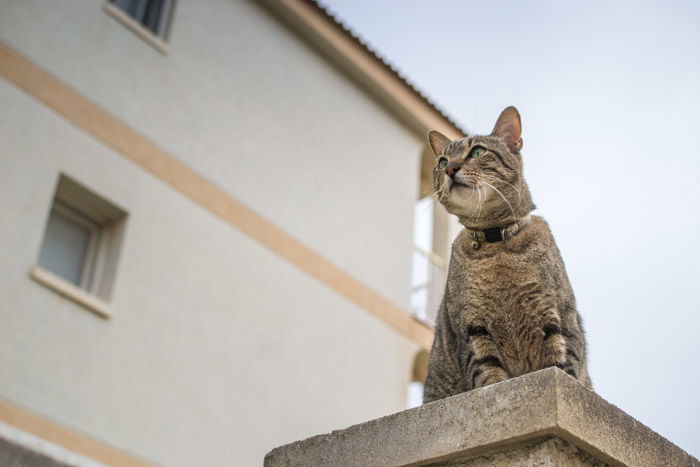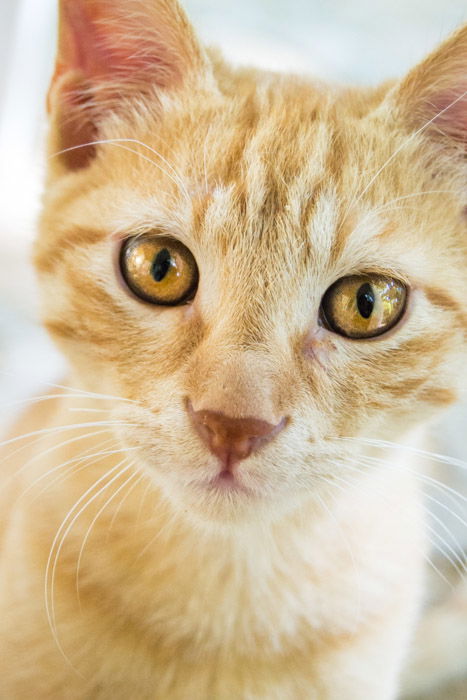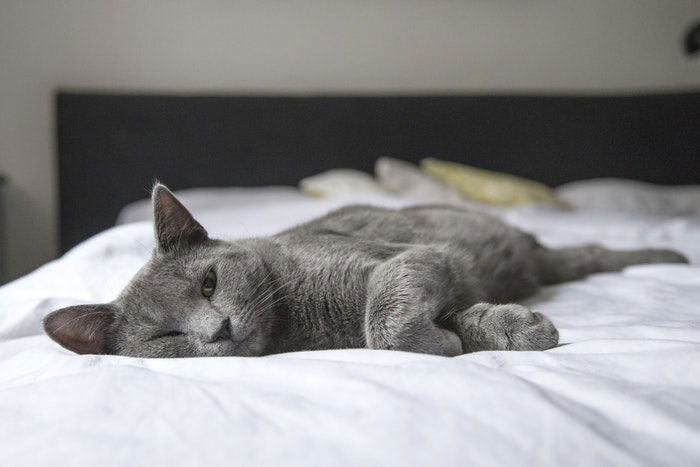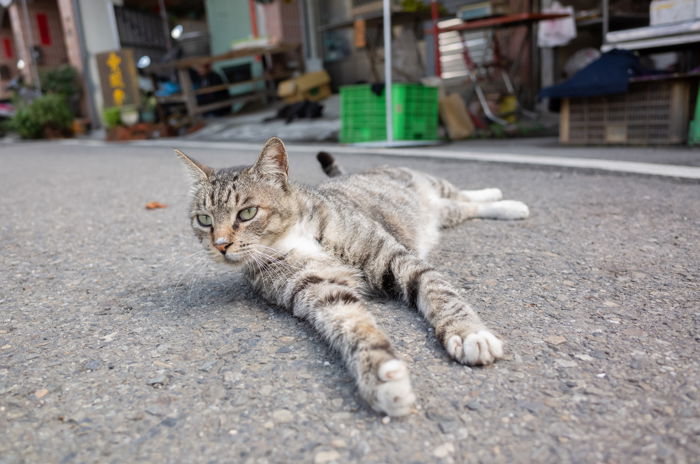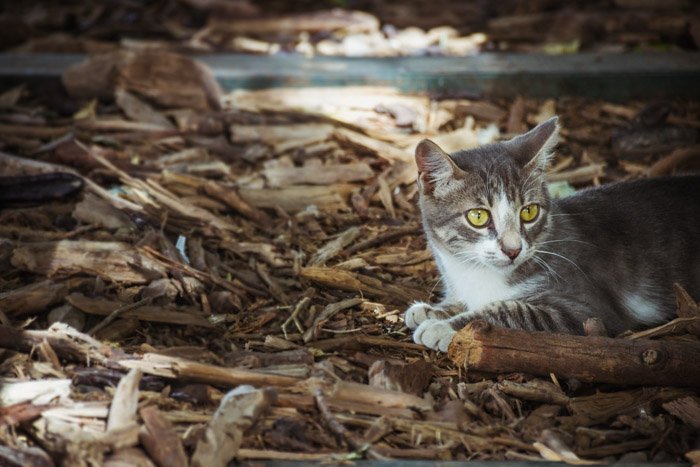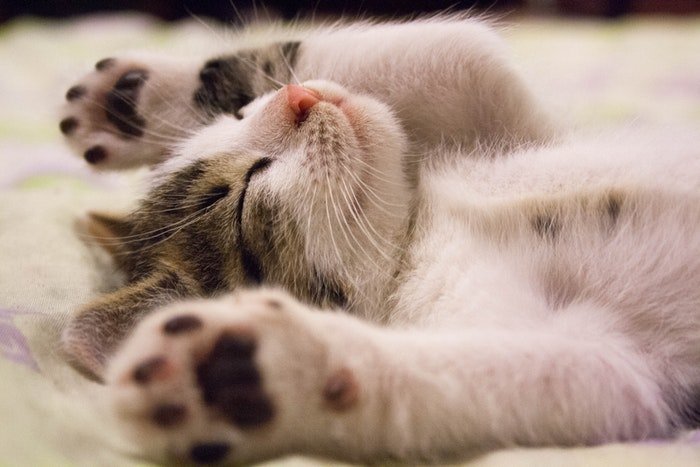I used to live in a town full of cats. As a photographer, this meant I photographed many cats and learnt a great deal about cat photography. I ended up taking cat photos almost every day. Cat photography is a fun and interesting niche of pet photography. Here you have my best 11 tips to improve your cat photography. [ExpertPhotography is supported by readers. Product links on ExpertPhotography are referral links. If you use one of these and buy something, we make a little bit of money. Need more info? See how it all works here.]
11. Cat Photography: Using a Semi-Automatic Shooting Mode
Unless they are sleeping, cats can be fast and unpredictable. It’s good to be ready to shoot fast and shooting with a semi-automatic mode can really help you to speed up. Aperture mode (called Av or A in most of the cameras) is the favourite among wildlife photographers. Be aware of using really low apertures though (f 1.8 f 2.2…). You might unintentionally set the depth of field to be too narrow. That can ruin your cat photo (if the cat moves, it will be out of focus). You need to choose which aperture will be best to keep everything important in the image in focus. To compensate for higher apertures, you will need to use slower shutter speeds. This is not always the best option when the animal is moving. Or you can increase the ISO instead. Shutter priority mode (often called Tv or S, depending on the camera) is another helpful option. With this one, you choose the shutter speed. With cats, it is usually good not to go under 1/125 or 1/250 seconds. Your camera will then adjust the aperture to get a well-exposed photo. This might be a good approach when you are working under good light conditions. But with low light conditions (dark environments, dusk, etc.), things get a bit more complicated. When pushing the camera to use really fast shutter speeds with low lighting, it will select really low aperture values. You will also need to use such high ISO values (more than 6400) that you might end up with a really grainy, out-of-focus photo.
10. Photograph Cats Using Different Angles
Cats are not the tallest animals. Photographing cats from your eye-level downward you can get really nice high angle photos. This perspective emphasises the face and eyes of the cat. Pay attention because it can cause a bit of distortion to the photo, so it might give a comic touch to the image. Cats are pretty good with heights. They like climbing on trees, walls and any other tall structures. You can emphasise this behaviour by taking photos from a low angle (pointing the camera up). If you go down to the cat’s eye-level, you can take really nice photos without distortion. As you are at the cat’s height, you are also looking at the world like they do.
9. Use Continuous Shooting Mode
Cats can be unpredictable, so getting that amazing cat photograph can be quite hard. You can increase your chances of catching a good moment by using the continuous shooting mode. This is also called Burst mode or continuous high-speed mode. Most cameras these days have it. It will allow you to take several images in quick succession. Try to read the cat’s behaviour, when you think it is about to act, start to take pictures. You will end up with quite a few photos, so it will take time to sort through them and find the best shots. But your chances of getting the best shots will increase! The number of photos and how to activate it depend on your camera model, so I recommend going through your camera manual. Just make sure to deactivate it once you don’t need it. Shooting all the time in continuous mode will fill-up your memory cards really fast!
8. Focus on the Cats Eyes
The point that is in focus in the image is the point where the eyes of the viewers will be drawn. In portrait photography, it is recommended to focus on the eyes of the model. Eyes convey emotions, and we are naturally attracted to them. The same is true for cat photography. Cats have these mysterious and beautiful eyes. If you get them sharp, it will look stunning. You can also break this rule and get great cat photos focusing on other parts of their bodies. Paws are great for close-ups, for example.
7. Take Medium Shots and Close-Ups
You can tell different stories about a cat depending on the distance between you and the subject. You can take a wide shot that includes a lot of the environment. This shows where the cat lives or stays. Keep in mind, though, when taking wide shot photos, you can easily miss the cat. Although these little guys have a lot of personality, they are small in size. As you want the cat to be the main character, medium shots and close-ups are a better choice. In a medium shot, the subject takes up more of the frame than in a wide-angle one. They include a bit of the environment too. These are great images to introduce the subject and their surroundings.
6. Get Close to Your Subject
In a close-up, the subject (the cat in our case) fills up most of the frame and the environment is barely visible. The subject is clearly the main focus of the image. For these types of shots you will need to get really close to the cat. Depending on the cat, you may need to be silent and approach it really slowly. Make a little step towards the cat and stop. Check if it looks suspicious or about to bolt. If not, take a second little step, stop again and check if the cat is fine with you being there. Repeat until you get to a comfortable distance to shoot from. Don’t make any sudden movements or change from standing to kneeling too fast. The trick here is to move slowly and softly, like the guys from the National Geographic documentaries. Another option, as in other types of animal photography, is to stay far from the animal and use a telezoom. If you do so, take into account that the longer the focal length you use, the faster the shutter speed you need. This is because longer focal lengths increase the effect of camera shake.
5. Be Patient
This tip is especially relevant when you are taking photos of stray cats or cats that don’t know you. Cats are usually suspicious by nature. If you get too close to them too fast, they will run away before you even have the time to take a single shot. Don’t take it personally. Instead, let them get used to you progressively. Cats are territorial, so they tend to hang around specific places. If you have the chance, spend time close to them as frequently as possible. This doesn’t mean that you should go there and try to touch them or play with them. Just be there, observing, learning about their behaviour, getting to know them a little. Each cat has its own personality, so after some time you can get to know which one is the boss of the territory, the fearful cat, the extra curious, or the friendly one. These two last are especially relevant. They are the ones that will open up towards you first and be easiest to photograph.
4. Take Advantage of Their Curiosity
Cats are curious animals. You should use this to your advantage. Some cats are more inquisitive than others, but in general terms, these little felines like to know what you are doing. Thanks to that, you can use some tricks to make them look at the camera. Make noises with some leaves or crumbling paper, and they will probably look in the direction of the sound’s origin. Show them something, especially if it is hanging from a cord, and move it from one side to another. They will follow the movement or even go and try to catch the object. Some of the cats, especially if you close to them, show curiosity for the camera. They are attracted by the DSLR noise made when shooting. After taking a first photo, chances are that the cat will look straight at the camera, so be ready to shoot again!
3. Be Open-Minded About the Results
If a cat is familiar with you and it is tamed, you might be able to make them pose in a particular way by using some tricks. But with stray cats, the most common situation is that the cat decides to show its own personality and will end up either ignoring you or doing whatever it wants. Usually, this is exactly the opposite of what you wanted it to do. Cats have this talent. At this point, the best thing to do is to be open-minded and accept that these little felines are a bit wild. Take a deep breath and keep taking photos of whatever the cat is doing. You might be pleasantly surprised by the results.
2. Always Be Ready to Shoot
This is an easy recommendation, and it might seem quite obvious. But in real life, it is quite common to miss a shot just because it took us too long to get the camera ready. With cat photography, it is even worse. Cats are fast, and they usually don’t repeat their actions just for us to take photos. Always be ready. Pick the settings needed for the light situation and keep the camera close at hand. If you want to check the images on your screen to make some adjustments, do it fast. Don’t get distracted going through all your photos. It might happen that when you raise your head form the screen, the cat is gone!
1. Don’t Use Flash, Especially with Kittens
If light conditions are not the best, you might think about using the flash. But cats are not the biggest fans of these strong and sudden light bursts. You might scare them to the point of running away. And in the case of kitten pictures, you might even damage their delicate eyes. Instead of using flash, open the aperture of your camera, lower the shutter speed, and increase the ISO value to increase light sensitivity. Another alternative is to use an LED light that won’t annoy them nor make them run away. You can start by using the LED light at really low intensity and increase it progressively when the animals get used to it.
Conclusion


